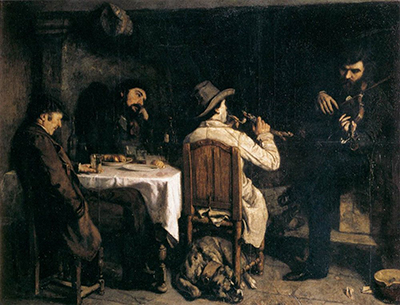After Dinner at Ornans was an early sign as to Courbet's love for his rural environment, happily turning against convention to provide realistic depictions of those who lived and worked in his home town.
Coming, as it did, in 1848-1849, the artist was just starting to firm up a solid reputation for the first time. This huge painting can now be found at the Palais des Beaux-Arts de Lille but it would have struggled for such respect at the time of its completion, because some forces within French art were very much against his style. They considered it ugly and promoting the lives of people that they considered not worthy of their interest. The dark tones were also not to their liking, even though the likes of Rembrandt and Caravaggio had already proved successful with a broadly similar approach.
The composition shows several middle aged men relaxing after a large meal. A musician on the right hand side entertains the patrons who sit together in a darkly lit room. Everything in the scene suggests that these are not wealthy people, perhaps hard working rural workers who are taking a rare opportunity to rest and relax after a hard week's work. Courbet took in a number of figures such as this during his work in rural locations, including a servant in The Meeting and also a whole plethora of local people in Burial at Ornans. His family were wealthy farmers who backed him to pursue his artistic career but he never really left this region behind, preferring to return here after several years in Paris.
Some research has been completed into this painting and the individuals have finally been identified. Regis, the artist's father, sits on the left hand side. Three of his friends make up the rest of the scene, with Urbain Cuenot, Adolphe Marlet and Alphonse Promayet sitting alongside. Despite the resistance at the time, this painting now holds a place in the realms of great French art, being particularly prominent within all that came from the 19th century. Crucially, the artist received a gold medal for this piece, which meant that his controversial paintings no-longer had to be reviewed by the Salon anymore.




